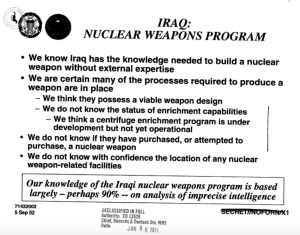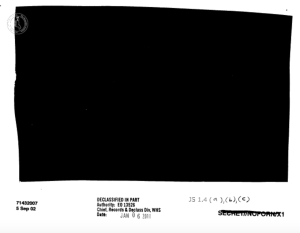As I noted yesterday, the 7th Circuit has permitted a Bivens lawsuit against Donald Rumsfeld to move forward.
I wanted to turn to a dispute not resolved in the opinion, which should be: whether or not Rummy changed the Army Field Manual after the Detainee Treatment Act so as to permit ongoing use of torture.
As the opinion notes, plaintiffs Donald Vance and Nathan Ertel claim that not only did Rummy ignore the DTA’s prohibition on torture, he secretly changed the Army Field Manual to permit it.
The plaintiffs contend that, after the enactment of the Detainee Treatment Act, Secretary Rumsfeld continued to condone the use of techniques from outside the Army Field Manual. ¶ 244. They allege that on the same day that Congress passed the Detainee Treatment Act in December 2005, Secretary Rumsfeld added ten classified pages to the Field Manual, which included cruel, inhuman, and degrading techniques, such as those allegedly used on the plaintiffs (the plaintiffs refer to this as “the December Field Manual”). Id. The defendants describe this allegation as speculative and untrue, but we must accept these well-pled allegations as true at the Rule 12(b)(6) stage of the proceedings.8
On appeal, the plaintiffs 8 cite a newspaper article reporting on the development of this classified set of interrogation methods. See Eric Schmitt, “New Army Rules May Snarl Talks with McCain on Detainee Issue,” New York Times (Dec. 14, 2005), available at http://www.nytimes.com/2005/12/14/politics/ 14detain.html (last accessed Aug. 4, 2011) (“The Army has approved a new, classified set of interrogation methods . . . The techniques are included in a 10-page classified addendum to a new Army field manual . . .”). The plaintiffs contend that Secretary Rumsfeld eventually abandoned efforts to classify the Field Manual, but that the “December Field Manual” was in operation during their detention and was not replaced until September 2006, after plaintiffs had been released, when a new field manual (Field Manual 2-22.3) was instituted. ¶ 244; Pl. Br. at 11. The dissent criticizes plaintiffs’ reliance on the newspaper report, but plaintiffs’ case for personal responsibility rests on allegations that are far more extensive. In any event, these are disputes of fact that cannot be resolved by a Rule 12(b)(6) motion.
But the thing is, Vance doesn’t need to rely on this newspaper article to prove a version of Appendix M authorizing their torture exists. They can rely on Steven Bradbury’s opinion describing Appendix M as it existed during their torture.
As a reminder, Vance and Ertel were detained by American troops around April 15, 2006 and sent to Camp Cropper a few days later; Ertel was released in May 2006 and Vance was released July 2006. While there, they allege, they were subjected to:
exposure to intolerable cold and continuous artificial light (no darkness day after day) for the duration of their imprisonment; extended solitary confinement in cells without any stimuli or reading material; blasting by loud heavy metal and country music pumped into their cells; being awoken by startling if they fell asleep; threats of excessive force; blindfolding and “hooding”; and selective deprivation of food and water, amongst other techniques.
On April 13, 2006, just days before Vance and Ertel’s torture started, in a memo for the file assessing whether changes to the AFM complied with the DTA, Steven Bradbury described Appendix M as it existed at that time. His description makes it clear that DOD had added six techniques not otherwise allowed by the AFM.
Appendix M of the FM 2-22.3, provides guidance for the use of six “restricted interrogation techniques” that are otherwise not permitted by the Field Manual.
Now, DOJ redacted four of the six techniques in releasing this memo under FOIA (the two left unredacted are “Mutt and Jeff” and “False Flag”). But comments that remain unredacted later in the memo make it clear that they involve precisely the kind of environmental manipulation, sleep deprivation, and solitary confinement inflicted on Vance and Ertel. Bradbury writes:
Similarly, the three “Adjustment” techniques are designed to change the detainee’s environment [3/4 line redacted] but without depriving him of any basic necessities or exposing him to dangerous or tortuous conditions. Whether these techniques are used separately or in tandem, the detainee is guaranteed to received adequate levels of food, water, sleep, heat, ventilation, and light. In addition, the detainee’s health must be continually monitored by medical personnel. These safeguards ensure that these techniques do not involve the infliction of punishment and negate any inference that they represent deliberative indifference.
Finally, the “Separation” technique expressly requires that the “basic standards of humane treatment” be maintained even though the detainee may be isolated from other detainees. A detainee subjected to this technique does not undergo sensory deprivation and thus is far less likely to suffer the adverse physiological consequences associated with that experience. M-51. In addition, the Separation technique is carefully limited in duration, which is not to exceed 30 days without express authorization from a senior military officer. With these limitations in place, and given the important role isolation can play in conditioning detainees for interrogation (including limiting the ability to frustrate or mislead interrogators by sharing information about the interrogation process), the Separation technique does not amount to punishment and is not shocking to the conscience. [my emphasis]
Bradbury’s description of detainees receiving adequate food and water, sleep, warmth, and light make it clear these are precisely the environmental factors manipulated under the “Adjustment” techniques. And his discussion of “Separation” makes it clear Bradbury is describing solitary confinement. Thus, while the description of these techniques may be redacted, they clearly must describe the techniques used on Vance and Ertel.
Now, at one level this memo–if Rummy weren’t pretending it didn’t exist–might help his case. After all, like the Yoo memos before it, this memo gives legal approval for torture, in this case stating that Appendix M techniques did not violate DTA.
But there are several reasons why, as used with American citizen non-combatant, the memo does not apply. Bradbury reveals, for example, that these techniques “may be used only during the interrogation of ‘unlawful enemy combatants’.” Vance and Ertel were actually given a detainee review board, and were called Security Internees, not Enemy Combatants.
Further, Appendix M as it existed when they were tortured “required that detainees receive adequate medical care,” something Vance and Ertel were specifically denied.
In addition, Appendix M prohibited the use of threats; but threats of “excessive force” were used with Vance and Ertel.
There’s one more out that Rummy might try to take. As I described in this post, this memo uses a structure I’ve not seen in any other OLC memo. Bradbury notes that he sent a letter (also on April 13, 2006) to DOD General Counsel Jim Haynes “advis[ing] that these documents are consistent with the requirements of law, in particular with the requirements of the Detainee Treatment Act of 2005.” We don’t have that letter. Rather, we have the memo that Bradbury wrote to the file. In other words, we have no way of knowing whether Bradbury communicated his caveats tying (for example) medical care to his judgment that the techniques described in Appendix M complied with the DTA (though we do know that the highest levels of DOD were involved in this approval process).
Now, aside from the fact that Bradbury’s direct quotes make it clear that those limitations were in Appendix M itself, there’s another problem with this. Both Bradbury’s unusual gimmick–as well as his subsequent failure to disclose it to Congress when specifically asked–is itself evidence that DOD and OLC were trying to hide their efforts to get around the clear meaning of DTA.
Here’s the specific refutation Rummy’s team made that his DOD revised the Army Field Manual before the torture of Vance and Ertel.
Nor is plaintiffs’ allegation that defendant Rumsfeld “modified” the Field Manual on “the same day Congress passed the DTA” to add “ten pages of classified interrogation techniques that apparently authorized, condoned, and directed the very sort of violations that Plaintiffs suffered.” SAC ¶ 244. Apart from relying on pure guesswork about the contents of supposedly classified information plaintiffs have never seen, there is no credible factual basis for the theory that the Field Manual was modified in any manner on December 30, 2005 (the DTA’s date of passage) or even in “December 2005,” id. ¶ 245, or that some portion of it is classified. To the contrary, the only update of the Field Manual since September 1992 was in September 2006, and no part of either of these versions is classified. Both the 1992 and 2006 Field Manuals are matters of public record and can be viewed in their entirety on the Internet at: www.loc.gov/rr/frd/Military_Law/pdf/intel_interrrogation_sept-1992.pdf (1992 Field Manual) [my emphasis]
Rummy claims that his DOD did not have a classified version of Appendix M; Rummy claims they didn’t update the AFM before September 2006.
Except his General Counsel got approval from OLC for that updated classified version of Appendix M just days before the torture on Vance and Ertel started.


